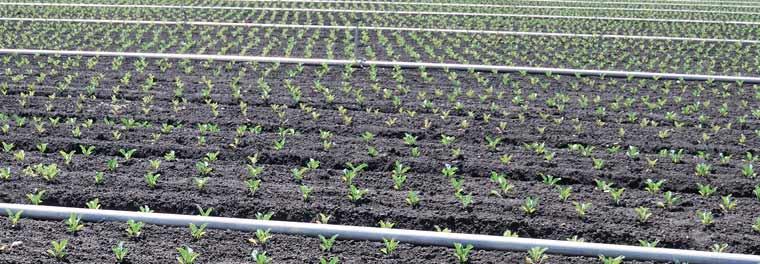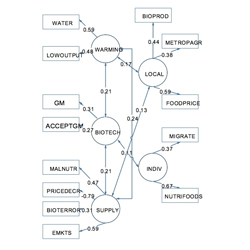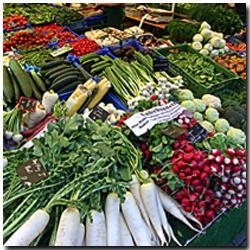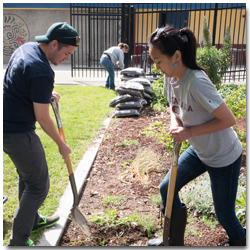
Follow CFIE on Social Media
Food and Agriculture
Agribusiness 2030 Scenario Analysis

This research reports the results of the analysis of surveys and focus groups of a large number of international experts on the future direction of agribusiness industry. Several scenarios are developed and explored. The most likely scenario, called Panta Rei, or Everything Moves, includes increasing effects of global warming, greater concentration of food industry and trade, increasing importance of local food production systems, greater application of biotechnology, more individualization in food consumption, and more food supply problems. To read the full report, visit: http://www.ifama.org/resources/Documents/v17i4/Lakner-Baker.pdf
Best Breads Looks to Improve Profitability Case Study
The case explores the poor performance of a medium- to large-scale baker as management attempts to determine the root cause of poor performance. Production, supply chain, and financial issues are addressed in the case.
Mi Pueblo Foods Case Study
This case study focuses on a local supermarket chain that targets the Hispanic market. The case explores the opportunities and challenges as management considers whether it should open a store in a food desert that has a high crime rate.
Organic Produce Industry and the Rise of Marketing Order Discontentment

This study provides an analysis of California's organic producers' perspectives on current agricultural marketing orders and the impact these marketing orders activities have on the sale of certified organic produce. Data were collected from interviews, focus groups, and surveys of California organic producers. The top alternatives for change were modifying existing marketing orders to allow for promotion of organic produce and allowing organic growers the freedom to use the funds to promote their organic products. To read the full report, visit http://www.ifama.org/resources/Documents/v18i4/Cosentino-Baker.pdf
Front-of-Package Nutritional Labeling’s Influence on the Perceived Healthiness of Packaged Dinners
In making food purchases, consumers are confronted with product labels that may be inconvenient to access and difficult to interpret. Access to such information is critical to ensure that consumers make healthy food choices. Front of Package (FOP) nutritional labeling allows consumers to be able to quickly interpret the nutritional information of a product and ensure that it aligns with their purchasing preferences. We analyze the ability of different FOP label formats to communicate nutritional information to consumers and measure to what degree these labels influence their food purchasing decisions.
Childhood Obesity Survey
We examine the problem of childhood obesity in the United States from the perspectives of parents, teachers, pediatricians, and dietitians. Members from each of these groups are asked to respond to a series of questions regarding their perception of the seriousness of the problem, the causes of childhood obesity, and potential remedies. The study is unique in that it compares survey results collected in both 2005 and 2014. We expect to report on preliminary findings in the coming weeks.
The Forge Community Garden

Santa Clara University's ½ acre organic garden serves the campus as a space for course research, service learning, and sustainable food production. Operating within the Center for Sustainability, the Forge Garden provides a living laboratory for exploration of environmental impacts and social justice surrounding the food system.
The Center for Food Innovation and Entrepreneurship has funded the Forge Garden and it’s Bronco Urban Gardens program since it began in 2009. BUG provides environmental and food justice oriented community-based learning opportunities for SCU students. It improves urban sustainability and environmental and food justice, develops and mentors a new generation of environmental leaders and creates new models and strategies for just and sustainable community development with a focus on a socially just and sustainable urban food system.
To learn more, visit: The SCU Forge Garden
Food Waste Recovery from Supply Chains for Use in Food Donation Programs
The Center for Food Innovation and Entrepreneurship is researching the extent of food losses and waste in northern California, with support from the Bank of America Foundation. The focus of the research will be on identifying the potential to salvage fresh vegetable and fruit produce that currently does not enter the food chain. Previous studies of food waste have highlighted food waste at the retail and consumer level, because the initial concern was to reduce the volumes of waste that were transported to urban land-fill sites. However, fresh produce marketing standards in the USA are stringent, and result in rejection of large volumes of edible food that would be good to eat, but does not fit size, shape, surface blemish or discoloration specifications. Large volumes of sub-standard produce are plowed in or diverted as low-value animal feed. The on-farm losses have largely been ignored in most other studies of food waste.
Prior studies have not attempted to collect data on farm-level losses for individual vegetable or fruit species. CFIE student researchers will be exploring the extent to which avoidable loss and waste occurs for the each of the highest volume produce items, such as lettuce, berries, tomatoes, apples, grapes, citrus, potatoes, onions, sweet corn, sweet peppers, broccoli, melons, carrots, stone fruit, avocados, cabbage and spinach. They will contact many growers in Santa Clara and six other nearby counties that are major fresh produce supply sources to obtain data on which to develop their estimates. Farm visits, phone interviews and targeted questionnaire mailings will be used to ensure that a large sample of farmers are contacted, and that robust conclusions are reached in this study.
The research will focus on developing detailed numerical data on food harvest disposal volumes and percentages for key fresh produce items. This is intended to establish a model for further investigation in other geographies. The purposes are to:
- identify priority supply shortfalls of fresh produce items at Food Banks,
- research the extent of on-farm waste and loss for these items, crop by crop,
- assess what proportion of this volume is salvageable for human consumption (i.e. currently discarded for cosmetic rather than substantive defects),
- propose cost-effective methods of procuring salvaged products for needy families.